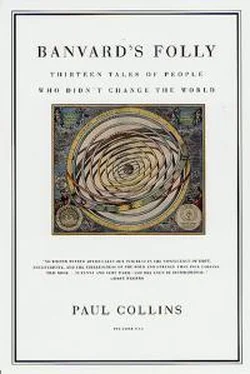"icy circle" blocked by towering icebergs and crashing fields of floating ice: After coasting the base of several icebergs and making our way through the field-ice floating around us, we reached the neighbourhood of a long and dangerous reef. ... The dashing of the heavy swell upon the breakers, as it poured from the south, heaved in vast quantities of field-ice. As they plunged forward upon other floes in advance, the whole body was broken into atoms, and a mist, like the smoke from the crater of a volcano. ... Let the imagination of the reader picture the savage features of the shore, whence the overtowering cliffs of ice are not unfrequently separated from the main body by the undermining rush of the billows; let him conceive the plunge of the
disparted ruin; the thundering crash of its collision with the ocean; the vortex of foam and spray which mark where it fell; and even then, be his fancy ever so vivid, he will fail to realize the sublime realities of the Antarctick.
Sublime as it was, it was also impassable. On their way back, the crew mutinied and stranded Reynolds and Watson, and then turned the Annawan from polar expedition to a more profitable trade: piracy. Reynolds wound up wandering the rocky shores of Chile, briefly served as a soldier in a tribal revolt, and eventually joined the passing frigate Potomac as a secretary, spending 1831 to 1834 circumnavigating the globe.
After returning, he quickly published a popular account of the Potomac's voyage, and then went back to earning his pay by lecturing on the poles and the hollow earth. At one lecture in Baltimore, it is thought that Henry Allan sat in the audience listening intently. He went home and related all he heard to his adopted brother--Edgar Allan Poe--and the greatest Symmes convert ever was created.
The hollow earth became an obsession for Poe. He was broke, alcoholic, and living on bread and molasses in cramped urban hovels with his tubercular teenage wife, and the notion of a wide-open frontier beneath his feet had an understandable pull upon his soul. His first published story, "MS Found in a Bottle," relates the disastrous end of a ship approaching one of the polar holes. In the only novel he ever wrote, The Narrative of Arthur Gordon Pym, the titular narrator discovers a lost Antarctic island populated by savage exiles from Symzonia, and breaks off in the closing lines with a kaleidoscopic plunge into the Interior World:
And now we rushed into the embraces of the cataract, where a chasm threw itself open to receive us. But there arose in our pathway a shrouded human figure, very far larger in its proportions than any dweller among men. And the hue of the skin of the figure was of the perfect whiteness of the snow.
When Poe printed the first installment of Pym in the January 1837 issue of the magazine he edited, the Southern Literary Messenger, he pointedly printed it alongside a factual lecture on polar exploration by Reynolds.
By mid-century, Jules Verne had steeped himself in the work of Poe, Reynolds, and Symmes enough that he wrote not one but three hollow earth works--a continuation of Poe's Pym titled An Antarctic Mystery, his 1866 novel The Adventures of Captain Hatteras, and his famous Journey to the Center of the Earth. These were not mere works of fancy. Not only had no one ventured far enough south to entirely disprove Symmes yet, but the 1848 discovery of a frozen woolly mammoth in the Siberian tundra seemed to prove Symmes's contention that just beyond the cold polar rim was a world plentifully populated by herds of animal life.
And if the ideas of Symmes had not yet faded, it was due in no small part to the efforts of his own family. It is a mark of Symmes's good nature that even after forsaking a steady career to face a decade of poverty, illness, and ridicule, he was most fondly remembered by his family. After his son Americus Vespucci Symmes erected the monumental obelisk to his father in Hamilton, he went on to publish a booklet updating his father's writings, The Symmes Theory of Concentric Spheres (1878). He did this in part because hollow earth theories had now become popular enough that other writers were passing off Symmes's ideas as their own.
For his zealous lobbying for his late father in newspapers and magazines, Americus received his own share of ridicule. When he sued a company for not
fixing holes in the local turnpike, during the trial their lawyer turned to the jury and archly remarked that "Mr. Symmes could see a hole where nobody else could, like his father before him: indeed, it seems to be a family failing."
Symmes's progeny could hardly help inheriting a propensity for ambitious pursuits of the impossible; another son, following in his father's quixotic footsteps, retired as a captain from the army and moved to Germany to build a
"flying-machine"--which, regrettably, did not fly.
By the late nineteenth century, expeditions had begun to approach the poles; the expected holes were not there, and thus the hollow earth theory fell in a decaying cultural orbit, sinking from dreamy scientific speculation to the discredited obsession of ignorant cranks and savvy charlatans. One such fellow was a Civil War veteran and quack herbalist bearing the melodious moniker Cyrus Reed Teed. He published a divine vision in 1870, The Illumination of Koresh: Marvelous Experience of the Great Alchemist at Utica, N.y. It argued that the earth was hollow and that we lived on the inner surface of the sphere, looking in toward a center filled with diminutive planets and stars.
At the center of it all was a sun that was light on one side and dark on the other, thus producing the effect of day and night.
A handsome and charismatic thirty-one-year-old, Teed at one point attracted up to four thousand mostly female followers. And like any good prophet, he declared himself the messiah and changed his name from Cyrus to the Hebrew equivalent, Koresh. He then proceeded to move his congregation to a commune outside Fort Myers, Florida. He prepared for the arrival of eight million followers in his self-proclaimed "Capital of the World." Two hundred showed up.
Teed had made a point of sending his key works, like Cellular Cosmogony (1898), to libraries around the world. These and his numerous pamphlets and magazines later turned up in, of all places, Nazi Germany. Nazism's anti-intellectual bent made the Reich susceptible to pseudoscience, and so when German aviator Peter Bender started preaching Teed's doctrine, it was not too surprising that his theory found some favor in the German Admiralty. But this interest didn't do Bender much good--he died in a concentration camp.
When Teed himself died in 1908, his followers had gathered and dutifully waited for him to resurrect himself. After a few days, though, the messiah had developed a definite pong, and finally local health officials pushed their way through the crowd and unceremoniously shoveled the immortal prophet into a waiting cart. Perhaps his ostensive employer was unamused by it all, for later Teed's body was swept out to sea in a hurricane.
Still, for a long and charming spell in the history of science, it was possible for a reasonable fellow to believe that entire worlds, unexplored and teeming with life, existed beneath our very feet. It is not strange that Edgar Allan Poe, who had spent much of his final days attempting a sort of unified field theory of the universe in his cryptic essay "Eureka," would cling until his last desperate moments to the majestic vision of Symmes and his disciples.
Poe had contracted rabies--enemies later claimed alcohol poisoning--and was found senseless in the streets of Baltimore. In the final and fatal stages of infection, delirious with a fever and maddened with the excruciating throat spasms of hydrophobia, he thrashed about in convulsions of agony on his hospital pallet. The nurses could not understand what he was raving after as he cried over and over for the unseen guide to the underworld that awaited him:
Читать дальше











